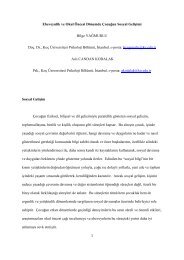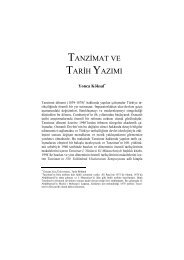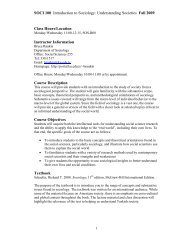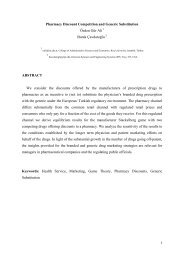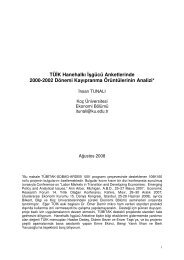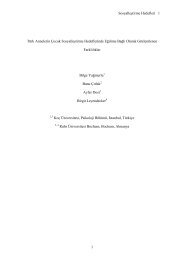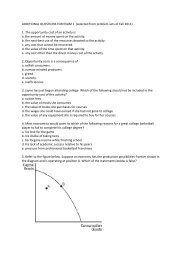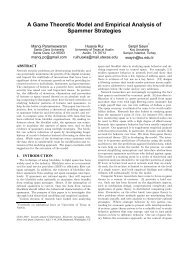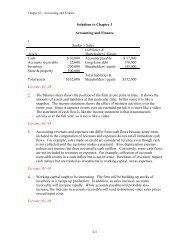Temperament and social development
Temperament and social development
Temperament and social development
You also want an ePaper? Increase the reach of your titles
YUMPU automatically turns print PDFs into web optimized ePapers that Google loves.
1Wiley-Blackwell H<strong>and</strong>book of Childhood Social Development: 2 nd edition“<strong>Temperament</strong> <strong>and</strong> <strong>social</strong> <strong>development</strong>”Authors: Ann Sanson, Sheryl Hemphill, Bilge Yagmurlu <strong>and</strong> S<strong>and</strong>ee McClowryThe Wiley-Blackwell H<strong>and</strong>book of Childhood Social Development, 2nd EditionPeter K. Smith (Editor), Craig H. Hart (Editor)ISBN: 978-1-4051-9679-6Hardcover672 pagesDecember 2010, Wiley-Blackwell£110.00 / €126.50List of Contributors.Introduction by the Editors (Peter K. Smith <strong>and</strong> Craig Hart).Part 1 Historical Overview.1. Historical perspectives on contemporary research in <strong>social</strong> <strong>development</strong> (W.Andrew Collins).Part II Disciplinary Perspectives on Social Development.2. Behavioral genetics (Alice M. Gregory, Harriet A. Ball, Tanya M. M. Button).3. Conceptual <strong>development</strong> <strong>and</strong> emotion: A neuropsychological perspective (StevenWoltering, Marc D. Lewis).4. Evolutionary perspectives on <strong>social</strong> <strong>development</strong> (David F. Bjorklund, Anthony D.Pellegrini).5. Historical reframing of childhood (Willem Koops).6. Cultural psychological perspectives on <strong>social</strong> <strong>development</strong> in childhood (HeidiFung).7. Sociological perspectives on <strong>social</strong> <strong>development</strong> (Gerald H<strong>and</strong>el).
324. Social play (Thomas G. Power).25. Cooperation <strong>and</strong> competition (Barry H. Schneider, Joyce Benenson, Marta Fulop,Mihaly Berkics, <strong>and</strong> Monica S<strong>and</strong>or).26. Aggression in children (Sarah M. Coyne, David A. Nelson, <strong>and</strong> MarionUnderwood).27. Bullying (Christina Salmivalli, Katlin Peets, <strong>and</strong> Ernest V. E. Hodges).Part VIII Cognition, helping, moral reasoning.28. Social cognition (Charlie Lewis <strong>and</strong> Jeremy Carpendale).29. Pro<strong>social</strong> behavior (Joan E.Grusec, Paul Hastings, <strong>and</strong> Alisha Almas).30. Children's <strong>social</strong> <strong>and</strong> moral reasoning (Charles C. Helwig <strong>and</strong> Elliot Turiel).31. Children's underst<strong>and</strong>ing of society (Martyn Barrett <strong>and</strong> Eithne Buchanan-Barrow).Part IX Intervention <strong>and</strong> Social Development.32. Intervening in childhood <strong>social</strong> <strong>development</strong> (Mary Ellen Voegler-Lee <strong>and</strong> JanisB. Kupersmidt ).33. The <strong>development</strong> of <strong>social</strong> competence in children with disabilities (Karen E.Diamond, Hsin-Hui Huang <strong>and</strong> Elizabeth Steed).34. Interventions for <strong>development</strong> of <strong>social</strong> skills among children in the developingcountries (Suman Verma <strong>and</strong> Rajani Konantambigi).
4<strong>Temperament</strong> <strong>and</strong> Social DevelopmentThis chapter reviews the ways in which child temperament impacts uponaspects of <strong>social</strong> <strong>development</strong>. We start by providing some background ontemperament as a construct, <strong>and</strong> theoretical propositions about the processes involvedin temperament-<strong>development</strong> associations. We then review the research literature onthe connections between temperament <strong>and</strong> peer relations, <strong>social</strong> competence <strong>and</strong>pro<strong>social</strong> behavior, <strong>and</strong> problematic <strong>social</strong> behaviors. In concluding comments, wehighlight areas in need of further research.1. What is temperament?1.1 Historical Background<strong>Temperament</strong> refers to constitutionally based individual differences inbehavioral style that are visible from early childhood. Ideas about temperament goback to ancient Greco-Roman times. However, interest in child temperament inmodern times dates particularly to the pioneering work of Thomas <strong>and</strong> Chess in theNew York Longitudinal Study (Thomas, Chess, Birch, Hertzig, & Korn, 1963).Responding to the prevailing environmentalism of the time, <strong>and</strong> drawing from clinicalinsights, they identified nine dimensions of temperament on which infants <strong>and</strong> youngchildren could be seen to differ, <strong>and</strong> which impacted upon their subsequentpsycho<strong>social</strong> <strong>development</strong>.1.2 Current conceptualizations of temperamentFollowing Thomas <strong>and</strong> Chess’s ground-breaking work, their nine dimensionalstructure of temperament became widely accepted, especially in clinical settings. However,a consensus is emerging that a smaller number of dimensions best represents the structure of
5temperament. These show considerable commonality across research studies (Rothbart &Bates, 1998). Two broad aspects of temperament are gaining wide acceptance: negativeemotionality or reactivity, <strong>and</strong> self-regulation. Reactivity refers particularly to irritability,negative mood, <strong>and</strong> high-intensity negative reactions; it is sometimes differentiated intodistress to limitations (irritability, anger) <strong>and</strong> distress to novelty (fearfulness). Selfregulationrefers to the effortful control of attentional processes, <strong>and</strong> includes persistence<strong>and</strong> non-distractibility. Another factor, labeled approach/withdrawal, inhibition orsociability, describes the tendency to approach novel situations <strong>and</strong> people, or conversely towithdraw <strong>and</strong> be wary. Other narrower-b<strong>and</strong> factors such as activity level <strong>and</strong> rhythmicity ofbiological functioning also emerge in some studies.A number of researchers have used the categorization system, developed byThomas <strong>and</strong> Chess, of ‘easy’ <strong>and</strong> ‘difficult’clusters of children. ‘Difficult’ childrentended to be negative in mood, withdrawing, unadaptable, highly intense <strong>and</strong>arhythmic, <strong>and</strong> Thomas et al. (1963) documented more troubled <strong>development</strong> forthem. In later research these dimensions have not clustered together, <strong>and</strong> differentresearchers have tended to create their own definitions of ‘difficultness’, resulting inproblems in comparing studies. The ‘difficult’ construct carries value-ladenovertones, <strong>and</strong> ignores the fact that any temperament characteristic can be easy ordifficult, depending on the dem<strong>and</strong>s of the situation. Use of these global categoriesalso impedes progress in underst<strong>and</strong>ing the specific roles of particular temperamentdimensions for specific aspects of <strong>development</strong> (Sanson & Rothbart, 1995). The‘difficult’ construct is thus relatively unhelpful in a research context. However, in theresearch to be reviewed, a multiplicity of temperament constructs have been used,ranging from ‘micro’ aspects such as soothability or anger, to globalconceptualizations such as ‘difficult’ or ‘easy’.
6It is generally accepted that temperament is biologically based (see Rothbart &Bates, 1998 for review). There is some evidence of heritability, more for some aspectsof temperament than others. Models from neuroscience <strong>and</strong> some specificpsychobiological variables are being explored for their applicability to temperamentresearch. However, more research is needed to fully specify the biologicalunderpinnings of temperament.1.3 Stability <strong>and</strong> changeIf there was little or no stability of temperament over time, it would be hard toargue for its importance as a contributor to children’s <strong>social</strong> <strong>development</strong>. Modest tomoderate stability across age is typically found, with correlations ranging from .2 to.4 (see Slabach, Morrow & Wachs, 1991). There are at least three explanations for thelack of higher stability estimates. First, even genetic underpinnings do not implyimmutability, <strong>and</strong> some aspects of temperament appear to show considerable<strong>development</strong> with age. Secondly, temperament can only be assessed from itsbehavioral manifestations which vary with age, making it difficult to ensure that thesame underlying temperament constructs are assessed at each age. Thirdly <strong>and</strong> mostsignificantly, correlational estimates of stability do not take into account measurementerror. Using structural equation modeling (which corrects for attenuation ofcorrelations due to measurement error) on data from the Australian <strong>Temperament</strong>Project (ATP) sample from infancy to 7-8 years, Pedlow, Sanson, Prior <strong>and</strong> Oberlkaidet al (1993) found considerably higher stability estimates, in the range of .7 to .8.Nevertheless, even at these levels of stability, there is still considerable room forchange in children’s temperament characteristics. Underst<strong>and</strong>ing the processingunderlying these changes is an important current research question (see Sanson &Rothbart, 1995).
71.4 MeasurementThere has been considerable debate about the measurement of temperament.Because temperament refers to the overall behavioral style of a child, rather than momentby-momentbehavior, primary caregivers who can observe the child across time <strong>and</strong>contexts have been considered appropriate informants, usually via parent-ratedquestionnaires. Findings of effects of such variables as maternal depression <strong>and</strong> stress ontemperament ratings (e.g. Mednick, Hocevar, Schulsinger, & Baker, 1996) suggest asubjective element to maternal reports. However, there is also evidence of reasonablevalidity (Bates, Bayles, Bennet, Ridge, & Brown, 1991; Allen & Prior, 1995). More studiesare now adopting observational measures, although these also have their limitations, beingrestricted in the time period <strong>and</strong> contexts in which observations can be made. While thecontroversies regarding measurement deserve more space than can be afforded here, it isgenerally agreed that the optimal solution at present is to use multiple measures oftemperament (Rothbart & Bates, 1998). Few studies currently achieve this goal.2. Theoretical underst<strong>and</strong>ings of the role of temperament in <strong>development</strong>It is one thing to document associations between temperament <strong>and</strong> <strong>social</strong><strong>development</strong>, <strong>and</strong> another to model <strong>and</strong> explain the <strong>development</strong>al processes bywhich temperament has its effects. Here we briefly outline some processes by whichtemperament is likely to impact on <strong>social</strong> <strong>development</strong>.Several broad categories of processes can be identified [see Rothbart & Bates(1998) <strong>and</strong> Sanson & Prior (1999) for fuller discussions]. Firstly, temperament mayhave direct linear effects on <strong>social</strong> <strong>development</strong>. For example, an extreme ranking ona temperament dimension may be synonymous with a particular outcome (thus veryhigh inhibition may be synonymous with <strong>social</strong> withdrawal). Another direct effect iswhen an extreme temperament characteristic leads to or directly affects an outcome
8(e.g. very high reactivity may predispose a child to aggressive responses tofrustration).Indirect linear effects, or mediated effects, include those where a child’stemperament affects the environment, which then impacts upon their adjustment. Ingeneral, children with different temperaments elicit different responses from peoplewith whom they come in contact – a cheerful sociable child is likely to experiencemore positive responses from others than a moody withdrawing one; <strong>and</strong> a highlynegative <strong>and</strong> reactive child might elicit punitive discipline practices from a parent,which in turn increase the child’s risk for aggressive behavior. This history ofdifferential reactions is then likely to impact on <strong>development</strong>al outcome.A third set of effects are interactional ones. Thomas <strong>and</strong> Chess (1977) proposedthat “goodness of fit” explains the impact of temperament; i.e. that particulartemperament characteristics ‘fit’ well with particular environments, <strong>and</strong> others ‘fit’poorly. Thus an active child in a cramped environment might do less well than thesame child in a spacious environment where their activity could be channeled in safe<strong>and</strong> productive ways. In a related fashion, Rothbart <strong>and</strong> Bates (1998) note thattemperament-by-temperament interactions are also plausible – for example, selfregulatoryaspects of temperament might change the expression of other potentiallyproblematic aspects of temperament (such as high activity level), promotingcompetent outcomes. Although it has been found hard to operationalize goodness offit (Paterson & Sanson, 1999), <strong>and</strong> findings of interactional effects are still relativelyscant, it remains a popular theoretical model.A more elaborated model is a transactional model (see, e.g., Cicchetti & Cohen,1995) which posits that <strong>development</strong> is the outcome of a continuous interactionamong intrinsic child characteristics <strong>and</strong> aspects of the environment. A child’s health
9status, their cognitive capacities <strong>and</strong> temperament, along with parent <strong>and</strong> familycircumstances <strong>and</strong> the prevailing sociocultural context, all need to be taken intoaccount in explaining <strong>and</strong> predicting <strong>development</strong>al pathways. In this model,temperament is often seen as a risk or protective factor.There is widespread acceptance among researchers that interactional ortransactional models best explain the <strong>development</strong>al process. However, as Rothbart<strong>and</strong> Bates (1998) note, interactions have been easier to talk about than find, <strong>and</strong> thereis currently most empirical support for linear additive effects. Limitations in methods<strong>and</strong> analysis strategies have undoubtedly restricted our capacity to uncoverinteractional effects, <strong>and</strong> recent advances such as latent variable <strong>and</strong> trajectoryanalysis techniques may help establish their existence.3. Conceptualization of <strong>social</strong> <strong>development</strong>The term <strong>social</strong> <strong>development</strong> is broad, <strong>and</strong> we will not attempt a definition here.Rather, we will restrict our discussion to aspects of <strong>social</strong> <strong>development</strong> for whichtemperamental contributions have been most investigated. The measures of <strong>social</strong>behaviors considered here range widely, including peer nominations, observedbehaviors, <strong>and</strong> ratings via checklists. We here adopt an inclusive approach, toaccommodate this heterogeneity. We will discuss research on both positive <strong>and</strong>problematic <strong>social</strong> <strong>development</strong>al outcomes. As an organizational device, we makedistinctions between different facets of <strong>social</strong> <strong>development</strong>, but acknowledge that thelines between these are often blurred.The first area to be discussed is children’s peer relations, with a particularemphasis on temperamental influences on the <strong>development</strong> of <strong>social</strong> withdrawal. Wethen turn to the <strong>development</strong> of positive <strong>social</strong> capacities, specifically the<strong>development</strong> of <strong>social</strong> skills, <strong>social</strong> competence, <strong>and</strong> pro<strong>social</strong> behavior <strong>and</strong>
10cognitions. Finally, we address temperamental contributions to problematic <strong>social</strong>behaviors, such as aggression <strong>and</strong> oppositional behavior. Throughout the review wedraw attention to age trends, as well as the influence of gender, <strong>social</strong> class <strong>and</strong>culture, although as will be seen the research base in many cases is extremely sparse.A note about methods: In this area of research, a recurring issue is thedifficulty of clearly separating, both conceptually <strong>and</strong> methodologically, thepredictive temperament factors from the <strong>social</strong> <strong>development</strong> outcomes. For example,wary behaviors <strong>and</strong> fearful affect in the face of novelty are commonly incorporated inmeasures of temperamental inhibition; however, they are also often part of thedefinition of <strong>social</strong> withdrawal. Further, if the same person (e.g. a parent or teacher)reports on both the presumed temperamental precursor <strong>and</strong> the <strong>social</strong> <strong>development</strong>aloutcome, it is likely that shared method variance accounts for some portion of anyassociation found. These difficulties mean that findings of associations betweentemperament <strong>and</strong> <strong>social</strong> <strong>development</strong> do not necessarily reflect causal relationships,<strong>and</strong> may in some instances be inflated due to contamination of measures or sharedmethod variance. While across-time associations derived from longitudinalmethodology do not in themselves establish causal linkages, they do allow moreconfidence to be placed in interpretations.We therefore focus our review on studies which meet at least one of tworequirements: a longitudinal design, <strong>and</strong> the use of different informants or methods of datacollection for the temperament <strong>and</strong> <strong>social</strong> <strong>development</strong> variables of interest.4. The Role of <strong>Temperament</strong> in Peer RelationsHere we review research on the role of temperament in children’s peer relationships,including children’s tendencies to withdraw from peers, to exhibit shyness or sociability inthe company of peers, <strong>and</strong> their status within the peer group. Gender <strong>and</strong> cultural differences
11<strong>and</strong> research suggesting the importance of temperament-by-parenting interactions arereviewed. We do not comment on <strong>social</strong> class differences, as most studies have usedmiddle-class samples, <strong>and</strong> we have not located any specifically addressing socioeconomicstatus (SES).Most research in this area has focused on the role of temperamental inhibitionin the <strong>development</strong> of <strong>social</strong> withdrawal. Inhibition is the disposition to be wary whenencountering novel or challenging situations, whereas <strong>social</strong> withdrawal refers toconsistent displays of solitary behavior when with peers (Burgess, Rubin, Cheah, &Nelson, in press). As noted above, some of the common indicators of inhibitionoverlap with those often ascribed to <strong>social</strong> withdrawal.4.1 Preschoolers (3- to 4-year-olds)Cross-sectional studies (e.g., Billman & McDevitt, 1980; Hinde, Tamplin, &Barrett, 1993), <strong>and</strong> longitudinal studies from infancy to preschool-age, indicate thatearly inhibition is associated with <strong>social</strong> withdrawal or lack of peer interaction inpreschool children (Kagan, Reznick, Clarke, Snidman, & Garcia-Coll, 1984; Sanson,2000). Parker-Cohen <strong>and</strong> Bell (1988) found that children low on inhibition <strong>and</strong> highin activity showed, concurrently, higher levels of teacher-reported peerresponsiveness. Task orientation (attentional self-regulation) <strong>and</strong> flexibility (positivemood, adaptability <strong>and</strong> approach) have also been associated with more peerinteraction (Keogh & Burstein, 1988), <strong>and</strong> highly persistent <strong>and</strong> active boys werefound to be more <strong>social</strong>ly interactive with peers, with boys low in persistence <strong>and</strong>activity having more negative interactions (Guralnick & Groom, 1990).4.2 Early school age (5- to 7-year-olds)Links have been found between toddler inhibition <strong>and</strong> observed <strong>social</strong>withdrawal at 5-7 years, especially when comparing groups of extremely inhibited or
12uninhibited toddlers (e.g., Kagan, 1988; Reznick, et al., 1986). Gersten (1988) foundthat children identified as inhibited at 21 months spent less time interacting with peers<strong>and</strong> more time alone at kindergarten than uninhibited toddlers. Kochanska <strong>and</strong> Radke-Yarrow (1992) reported that “<strong>social</strong> inhibition” (inhibition to an unfamiliar adult) intoddlerhood predicted shy, <strong>social</strong>ly withdrawn behavior with a peer at 5 years, while“non<strong>social</strong> inhibition” (to an unfamiliar environment) was associated with lessengagement in group play at 5 years, suggesting that different types of inhibition areassociated with somewhat different peer relationship outcomes.Concurrent relationships at this age have also been documented. For example,Skarpness <strong>and</strong> Carson (1986) found that 5-6 year old children who showed lessinhibition (by mother report) had more positive peer relations (by teacher report).Similarly, Stocker <strong>and</strong> Dunn (1990) reported that temperamentally sociable 5- to 10-year-olds were more popular with peers <strong>and</strong> had more positive relationships withfriends than less sociable children.4.3 Later elementary school age (8- to 11-year-olds)As with younger children, being inhibited as a toddler or preschooler has beenassociated with withdrawal from peers at 8-11 years (e.g., Eisenberg, Shepard, Fabes,Murphy, & Guthrie, 1998; Kagan, 1988). <strong>Temperament</strong>al dimensions other thaninhibition have received little research attention, but some relationships have beenfound. For example, Kurdek <strong>and</strong> Lillie (1985) found that rejected children in grades 3to 7 showed lower rhythmicity <strong>and</strong> poorer attention (both aspects of self-regulation).4.4 Sex differencesSex differences in this area have been somewhat neglected (Hinde et al.,1993). In one of few investigations, Skarpness <strong>and</strong> Carson (1986) found no sexdifferences in the links between mother-rated inhibition <strong>and</strong> teacher-rated withdrawal.
13However, Hinde et al. (1993) found that shy 4-year-old girls tended not to interactwith peers, whereas for boys there was no relationship between shyness <strong>and</strong> peerinteraction. Sanson, Smart, Prior, <strong>and</strong> Oberklaid (1996) investigated the earliertemperament characteristics that differentiated children classified (on the basis ofparent, teacher <strong>and</strong> self-report) as having problematic, competent or average peerrelationships at 11-12 years. For boys but not girls, impersistence <strong>and</strong> poor taskorientation, assessed from 1-3 years on, differentiated the problem group from theother two groups. Higher irritability <strong>and</strong> inflexibility (reactivity), assessed between 1-3 <strong>and</strong> 9-10 years, more clearly discriminated the problem group of boys from theother groups than they did for girls.In summary, there is suggestive evidence that temperament may have differentimplications for boys’ <strong>and</strong> girls’ peer relationships, although no clear-cut picture hasyet emerged.4.5 Cultural differencesDirect investigations of cultural differences in the links between temperament <strong>and</strong>peer relations are scant, generally focus on older children, <strong>and</strong> have almost exclusivelyconsidered Chinese <strong>and</strong> North American children. In a cross-sectional study of Chinese 8-10-year-olds (<strong>and</strong> one of few including participants with low SES), Chen, Rubin, <strong>and</strong> Li(1995) found that inhibited children were more accepted by peers <strong>and</strong> scored higher on“honorship” <strong>and</strong> leadership than children identified as aggressive or average. Chen <strong>and</strong>colleagues argued that in China, unlike North America, inhibition <strong>and</strong> shyness are thoughtto reflect <strong>social</strong> maturity <strong>and</strong> underst<strong>and</strong>ing <strong>and</strong> are therefore viewed positively. Theirfindings are thus an important demonstration of the fact that temperament in itself is neitherpositive nor negative, but that its effects can be mediated through cultural norms <strong>and</strong> beliefsystems.
14The mediating role of culturally-based parenting beliefs <strong>and</strong> behaviors was furtherdemonstrated by Chen et al. (1998), where the pattern of correlations between toddlerinhibition <strong>and</strong> parenting differed for Chinese <strong>and</strong> Canadian mothers. For example, forthe Chinese sample, inhibition was positively correlated with maternal acceptance <strong>and</strong>encouragement of achievement, but in the Canadian sample the correlations werenegative. These results again suggest that inhibition is desirable in China, <strong>and</strong>undesirable <strong>and</strong> problematic in Canada. Such cross-cultural comparisons, whenextended across a wider age range <strong>and</strong> a broader range of cultures, promise toincrease our underst<strong>and</strong>ing of how temperament works within a cultural context,through culture-specific parenting attitudes, expectations, <strong>and</strong> practices, to impact on<strong>social</strong> <strong>development</strong>al outcomes.4.6 Developmental models concerning links between temperament <strong>and</strong> peer relationsOne of the most comprehensive models of the <strong>development</strong> of <strong>social</strong> withdrawalis Rubin <strong>and</strong> colleagues’ ‘temple of doom’ model (e.g., Rubin, LeMare, & Lollis,1990; Rubin & Stewart, 1996). In this model, infant inhibition is considered apotential stressor to which, in the context of other family stressors, parents may reactnegatively (i.e., with insensitivity, overprotection <strong>and</strong>/or overcontrol), resulting ininsecure parent-child attachment. Insecure children may then withdraw from the<strong>social</strong> environment, <strong>and</strong> eventually be rejected by peers. Here temperament is seen asa risk factor whose effect is mediated by the parental behavior elicited by it. Otheraspects of temperament (e.g., reactivity, attentional control) are not specificallyaddressed in this model.Fox <strong>and</strong> Calkins (1993) have described a model which emphasises the interactionbetween infant reactivity <strong>and</strong> regulation of affect, along with parental influences <strong>and</strong>parent-child interactions. Different child outcomes are postulated for particular
15combinations of reactivity <strong>and</strong> regulation; for example, infants who are high in bothnegative reactivity <strong>and</strong> fearfulness may become isolated <strong>and</strong> withdrawn from peers asearly as 14 months of age (e.g., Kagan, Snidman, & Arcus, 1998). However, Fox <strong>and</strong>Calkins argue that parental support may alter the behavioral outcome. Strengths ofthis model are that it describes the role of the two broad dimensions of temperament(reactivity <strong>and</strong> self-regulation) <strong>and</strong> recognises the potential mediating influence ofparents on children’s outcomes.Consistent with a transactional model of <strong>development</strong>, a growing body ofliterature investigates the influence of temperament-by-parenting interactions onchildren’s peer relations. Some studies suggest that the association of inhibition withpeer relationship difficulties occurs particularly in the context of an overprotective<strong>and</strong> controlling parent (e.g., Burgess et al., in press).4.7 SummaryTo summarise, although most studies rely on concurrent data <strong>and</strong> there are manyresearch gaps, there is increasing evidence of associations between early temperament<strong>and</strong> later peer relations (particularly <strong>social</strong> withdrawal). There is also evidence ofdifferentiated paths from specific types of inhibition to particular types of peerrelations. While few studies have investigated temperament dimensions other thaninhibition, attentional self-control <strong>and</strong> reactivity also appear to be importantcontributors. To date, there is only suggestive evidence of sex differences in linksbetween temperament <strong>and</strong> peer relations, but cultural differences in the role ofinhibition suggest that temperament effects are likely to be mediated by parental <strong>and</strong>cultural expectations. Few studies have examined potential moderating <strong>and</strong> mediatingvariables, but promising <strong>development</strong>al models attempt to explain the causalprocesses underlying the links between temperament <strong>and</strong> peer relations. Future
16<strong>development</strong> of these models will need to elaborate the influence of temperament-byparentinginteractions on children’s peer relations.5 <strong>Temperament</strong>al contributions to <strong>social</strong> competence <strong>and</strong> pro<strong>social</strong> behaviorChildren’s temperament characteristics have been shown to be related toskilled <strong>social</strong> behavior <strong>and</strong> to pro<strong>social</strong> behavior <strong>and</strong> cognitions. Included here arereviews of studies assessing children's general levels of <strong>social</strong> competence <strong>and</strong> <strong>social</strong>skills, typically via checklists; studies investigating specific behaviors observedduring peer interactions; <strong>and</strong> research on pro<strong>social</strong> outcomes including empathiccapacities, conscience, sympathy, response to distress <strong>and</strong> helping behaviors. Sexdifferences are discussed, but no studies addressing <strong>social</strong> class or cultural differencesin the relationships of temperament to <strong>social</strong> competence <strong>and</strong> pro<strong>social</strong> behavior havebeen located, other than those by Chen <strong>and</strong> colleagues already discussed in Section4.5.5.1 Preschoolers (3- to 4-year olds)Dunn <strong>and</strong> Cutting (1999) investigated concurrent linkages between 4-year-oldchildren's temperament <strong>and</strong> the quality of their interactions with a friend. Negativeemotionality was unrelated to verbal communication patterns, but was related to'coordinated play' (e.g. agreeing with the other child's suggestion) which, whileappearing <strong>social</strong>ly competent, may reflect a more dependent interaction style. Whilethe majority of studies have involved white, middle class samples, Youngblade <strong>and</strong>Mulvihill (1998) used naturalistic observations of preschoolers from homelessfamilies. Children who were active, soothable or persistent more frequently displayedpositive behaviors than emotional or shy children. In a concurrent observationalstudy, Farver <strong>and</strong> Bransletter (1994) found children with an ‘easy’ temperament
17profile gave more pro<strong>social</strong> responses to peer distress than children who were ‘slow towarm up’ or ‘difficult’.Some of the most illuminating work in this area comes from Eisenberg <strong>and</strong>colleagues, focusing on the roles of temperamental emotionality, self regulation <strong>and</strong>their interaction. Eisenberg, et al. (1993) found that a composite measure of <strong>social</strong>skills (parent, teacher <strong>and</strong> observer report) was strongly predicted by highemotionality <strong>and</strong> low self-regulation capacities, with self-regulation being moresalient. Children who were both highly emotional <strong>and</strong> poorly regulated had lower<strong>social</strong> skills <strong>and</strong> sociometric status. Using naturalistic observation, Fabes, et al. (1999)found that <strong>social</strong>ly competent responding was associated with effortful control (e.g.inhibitory control, attentional focusing) only in high-intensity peer interactioncontexts (e.g., energetic, stressful, wild or loud interactions). Hence, temperamentseemed particularly relevant to <strong>social</strong> functioning in stressful <strong>social</strong> situations.Eisenberg, Fabes, Guthrie <strong>and</strong> Reiser (2000) propose that a moderate to highlevel of self-regulation is optimal for successful <strong>social</strong> functioning, <strong>and</strong> that negativeemotionality, in the presence of optimum regulation, does not lead to low <strong>social</strong>competence. Extremely high regulation is argued to lead to inhibited, over-controlled<strong>and</strong> less <strong>social</strong>ly skilled behavior. Low regulation is seen as a risk for externalizingbehavior problems <strong>and</strong> low <strong>social</strong> competence, particularly when high negativeemotionality is also present. Hence their model emphasises the importance oftemperament-by-temperament interactions, <strong>and</strong> points to the critical importance ofregulation capacities. These specific <strong>and</strong> testable predictions provide a valuabledirection for future research, although analysis strategies will need to take account ofthe hypothesized non-linear relationships.
18Most of these studies have used concurrent data. Thus some longitudinalstudies involving children less than 3 years old provide valuable additional insights.Transactional processes are suggested by the findings of Spangler (1990). Low levelsof ‘difficult’ temperament at 12 months were associated with observed maternalresponsiveness at 1-2 years, which in turn was related to higher <strong>social</strong> competence(more positive interactions, flexibility <strong>and</strong> cooperation) at 2 years. These resultssuggest reciprocal child-parent influences over time <strong>and</strong> emphasise the importance offamily <strong>and</strong> environmental factors, in addition to intrinsic child characteristics, in the<strong>development</strong> of <strong>social</strong> competence. <strong>Temperament</strong> also appears to play a significantrole in the process by which early developing feelings of guilt <strong>and</strong> empathy lead tointernalized feelings of responsibility, which in turn foster <strong>development</strong> of a moralsense <strong>and</strong> the expression of pro<strong>social</strong> or reparative behaviors (Zahn-Waxler &Robinson, 1995). Infant <strong>and</strong> toddler temperament ratings were used to predictempathy (response to an adult’s simulated distress) in a longitudinal study from 4months to 2 years (Young, Fox, & Zahn-Waxler, 1999). Toddlers who had displayedlow motor arousal <strong>and</strong> low levels of negative <strong>and</strong> positive affect as infantsdemonstrated less empathy towards an unfamiliar adult than toddlers with earlierpatterns of high motor arousal, high positive <strong>and</strong> low negative affect.Higherinhibition was concurrently associated with lower empathy <strong>and</strong> pro<strong>social</strong> behavior,although, as the authors note, this may have been due to inhibited children’sreluctance to engage with the adult.5.2 Early school age (5-to 7-year olds)The findings of Rothbart, Ahadi <strong>and</strong> Hershey (1994) suggest complex <strong>and</strong>distinct relationships between components of negative emotionality <strong>and</strong> aspects of<strong>social</strong> behavior. <strong>Temperament</strong>al fear (unease, worry), sadness (lowered mood or
19energy) <strong>and</strong> effortful control were related to empathy, guilt <strong>and</strong> shame. Aspects ofnegative affectivity reflecting irritability, such as anger or discomfort, were related toanti<strong>social</strong>, but not pro<strong>social</strong>, behaviors. These concurrent questionnaire-based datawere corroborated by longitudinal data from infancy which were available for asubsample of the children. Attention regulation (persistence, akin to effortful control)was also a powerful predictor of parent- <strong>and</strong> teacher-rated <strong>social</strong> skills among asample of 5-6 years old Australian children, accounting for 24% of variance (Paterson& Sanson, 1999).Kochanska <strong>and</strong> colleagues have investigated the role of temperament inconscience formation. Her model posits that experience of affect, guilt <strong>and</strong> anxiety inresponse to transgression, <strong>and</strong> behavioral control (which enables the child to inhibit orsuppress undesirable actions) contribute to conscience <strong>development</strong> (Kochanska,1993). Thus the model emphasises affective <strong>and</strong> self-regulatory aspects oftemperament, as well as cognitive components, <strong>and</strong> argues that conscience emergesthrough a subtle, evolving interaction between the child’s temperament <strong>and</strong> theparent’s child-rearing style.Several studies provide support for the model. Using observational <strong>and</strong>questionnaire measures, Kochanska, Murray <strong>and</strong> Coy (1997) investigated connectionsbetween inhibitory control, assessed at toddlerhood, preschool <strong>and</strong> concurrently, <strong>and</strong>early school-age conscience. Inhibitory control made a significant contribution atevery timepoint to the prediction of moral cognitions <strong>and</strong> behavior, leading theauthors to conclude that it plays a critical role in the <strong>development</strong> of conscience.<strong>Temperament</strong>-by-parenting interactions in the <strong>development</strong> of consciencewere found by Kochanska (1997). For fearful children, a gentle style of maternaldiscipline in toddlerhood facilitated conscience <strong>development</strong> at preschool age. For
20fearless children, higher attachment security <strong>and</strong> higher maternal responsiveness intoddlerhood predicted later conscience. Additionally, fearful <strong>and</strong> fearless childrendiffered in rate of conscience <strong>development</strong>, with fearful children apparently on afaster trajectory than fearless children. It seems that there are several pathways toconscience formation which relate differentially to child temperament <strong>and</strong> parentingstyle characteristics.5.3 Later elementary school age (8-to 12-year olds)Using data from the large representative ATP sample, the contribution ofconcurrent <strong>and</strong> earlier temperament to <strong>social</strong> skills (combined parent, teacher <strong>and</strong>child report) at 11-12 was investigated by Prior, Sanson, Smart, <strong>and</strong> Oberklaid(2000). Concurrent parent <strong>and</strong> teacher reports of temperament explained 48% of thevariance in <strong>social</strong> skills, with attentional self-regulation the most powerful predictor,<strong>and</strong> sociability <strong>and</strong> reactivity also contributing. <strong>Temperament</strong> data from 7-8 years ofage explained 20%, <strong>and</strong> from 5-6 years 16%, of the variance in <strong>social</strong> competence at11-12 years, with task orientation <strong>and</strong> flexibility being the most important predictorseach time. Reports of temperament at 1-3 <strong>and</strong> 3-4 years also predicted significant, butmodest, amounts of variance.<strong>Temperament</strong> contributions to children’s sympathetic capacities were explored in alongitudinal study by Murphy, Shepard, Eisenberg, Fabes, <strong>and</strong> Guthrie (1999). There weresignificant negative correlations between teacher-reported sympathetic tendencies at 10-12years <strong>and</strong> negative emotionality assessed concurrently <strong>and</strong> 2 <strong>and</strong> 4 years previously; <strong>and</strong>between negative emotionality <strong>and</strong> concurrent parent-reported sympathy. Positivecorrelations between regulation capacities <strong>and</strong> teacher- <strong>and</strong> parent-reported sympathy werefound contemporaneously <strong>and</strong> 2 years earlier. Self-regulation capacities explained unique
21variance after controlling for the effects of negative emotionality, but the reverse was nottrue. Here again, the critical role of self-regulation capacities is evident.5.4 Sex DifferencesSex differences emerge in a number of studies. Among pre-school aged boys,high levels of negative emotionality were related to poor <strong>social</strong> skills, <strong>and</strong> low levelsto good skills. Among girls, high emotionality was again related to low <strong>social</strong> skills,but girls with moderate <strong>and</strong> low emotionality did not differ in <strong>social</strong> skills (Eisenberget al., 1993). This suggests that high negative emotionality constitutes a risk for bothboys <strong>and</strong> girls, whereas low negative emotionality is protective only for boys.In a study of third through sixth graders, Eisenberg et al. (1996) found thatgirls were more <strong>social</strong>ly competent <strong>and</strong> popular than boys. Ratings of emotionalitywere inversely correlated with peer pro<strong>social</strong> nominations, although by parent reportfor girls <strong>and</strong> teacher report for boys. Only for boys was attentional regulation directlycorrelated with pro<strong>social</strong> nominations. Additionally, the interaction between negativeemotionality <strong>and</strong> attentional regulation exerted a significant influence on pro<strong>social</strong>nominations, but again sex differences were evident. Boys who were poorlyregulated were less popular <strong>and</strong> girls who were very well regulated were morepopular, regardless of level of emotionality. For boys with moderate or high levels ofregulation, <strong>and</strong> for girls with moderate or low levels of regulation, higheremotionality was associated with decreased popularity. Overall, these results suggestthe existence of complex sex differences in the relationships between aspects oftemperament <strong>and</strong> <strong>social</strong> competence from the pre-school age onwards, that may alsobe context-dependent.Kochanska, DeVet, Goldman, Murray <strong>and</strong> Putnam (1994), using a sample ofchildren from 21 to 70 months, identified two higher-order components of conscience,
22named Affective Discomfort <strong>and</strong> Moral Regulation/Vigilance. Girls had higher levelsof Affective Discomfort, which was predicted by higher reactivity <strong>and</strong> focus/effortfulcontrol, but no temperament dimensions were predictive for boys. For both sexes,high focus/effortful control was associated with higher Moral Regulation/Vigilance.Reactivity among girls <strong>and</strong> impulsivity <strong>and</strong> sensation seeking among boys wererelated to lower levels of Moral Regulation/Vigilance.Sex differences also feature in research on pro<strong>social</strong> outcomes. Girls areconsistently found to have higher levels of empathy, sympathy <strong>and</strong> conscience thanboys, <strong>and</strong> numerous sex differences are apparent in the connections betweentemperament <strong>and</strong> these aspects of functioning. Bryant (1987) found that emotionalintensity <strong>and</strong> low soothability were related to higher empathy for girls, but not boys.The teacher-reported relationships found between negative emotionality, regulation<strong>and</strong> sympathy described above (Murphy et al., 1999) were carried by significantresults for girls but not boys, while connections between parent-reported regulation<strong>and</strong> sympathy were carried by significant results for boys <strong>and</strong> not girls. Clearly this isan area deserving more systematic investigation, from which the need for genderspecificmodels of pathways may emerge.5.6 SummaryA small set of temperament dimensions are consistently associated withchildren’s levels of <strong>social</strong> skills. Of particular relevance are negative emotionality orreactivity (particularly intensity, irritability <strong>and</strong> mood), both emotional regulation (theability to control emotional arousal) <strong>and</strong> attentional regulation (maintaining attention<strong>and</strong> following tasks through to completion) <strong>and</strong> approach-sociability.For pro<strong>social</strong> capacities, the temperament dimensions of importance includeinhibition or shyness, emotionality, <strong>and</strong> self-regulation. Unlike the findings described
23in previous sections, here aspects of negative emotionality appear to contributepositively to a pro<strong>social</strong> outcome. This alerts us to the fact that negative emotionalitycomprises two aspects, distress <strong>and</strong> fear reactions, <strong>and</strong> irritability <strong>and</strong> anger – theformer appear implicated in the <strong>development</strong> of pro<strong>social</strong> behavior, whereas the latterare associated with poor peer relations <strong>and</strong>, as will be seen (Section 6) in aggressive<strong>and</strong> acting-out behaviors.While the majority of findings suggest direct linear relationships betweentemperament <strong>and</strong> these outcomes, evidence is accumulating that temperament-byparenting<strong>and</strong> temperament-by-temperament interactions are important contributors tothe <strong>development</strong>al processes involved.6. <strong>Temperament</strong>al influences on maladaptive <strong>social</strong> behaviorsOne of the most extensively researched issues in the temperament literature isthe contribution of temperament to the <strong>development</strong> of <strong>social</strong>ly maladaptivebehaviors, such as the externalizing spectrum of behavior problems (EBP) includingaggression <strong>and</strong> oppositional behaviors. Given several recent reviews (e.g. Rothbart &Bates, 1998; Sanson & Prior, 1999), only highlights of this research will be presented,focusing particularly on longitudinal studies which allow stronger conclusions to bedrawn about temporal <strong>and</strong> causal pathways. We also include findings from studiesinvestigating temperament contributions to problematic <strong>social</strong> interactions, such aspeer conflict <strong>and</strong> communication difficulties. Once again, there is an absence ofstudies on <strong>social</strong> class or cultural differences in the links between temperament <strong>and</strong>behavior problems.6.1 Preschoolers (3- to 4-year olds)In a playground observational study, Billman <strong>and</strong> McDevitt (1980) foundassociations between parent- <strong>and</strong> teacher-reported temperament dimensions of
24activity level, intensity, distractibility, threshold <strong>and</strong> rhythmicity <strong>and</strong> aspects of <strong>social</strong>behavior such as hitting, taking an object, <strong>and</strong> having an object taken from them. Datafrom two longitudinal studies have also documented associations between a ‘difficult’temperament profile <strong>and</strong> EBPs. In the large ATP sample, children with stablepatterns of aggressive behavior from 3-4 to 7-8 years were consistently distinguishedfrom transiently aggressive <strong>and</strong> non-aggressive groups on an easy-difficulttemperament factor (Kingston & Prior, 1995). They also had poorer mother-childrelationships, higher levels of sibling hostility <strong>and</strong> harsher parenting practices.Similarly, the Bloomington Longitudinal Study revealed modest associations betweentemperamental ‘difficultness’ (a combination of infant <strong>and</strong> toddler negative affectivity<strong>and</strong> attention-dem<strong>and</strong>ing characteristics) <strong>and</strong> EBPs at the pre-school <strong>and</strong> middlechildhood stages (Bates, et al., 1991). Resistance to control <strong>and</strong> low manageability at2 years were associated with conflicts with parents <strong>and</strong> parental managementdifficulties at the same age, <strong>and</strong> predictive of long term EBPs for boys.More specific associations have also been found. Hagekull (1994) found thattoddler impulsivity, activity <strong>and</strong> negative emotionality were predictive of EBPs at 4years of age. Concurrent positive correlations between emotionality, activity,persistence <strong>and</strong> approach-sociability <strong>and</strong> oppositional behavior problems were foundby Webster-Stratton <strong>and</strong> Eyberg (1982). In this study, mothers of more difficultchildren were observed to be more negative <strong>and</strong> non-accepting when responding totheir children, suggesting the presence of interactive processes.Concurrent <strong>and</strong> longitudinal relationships between emotional regulation(observed expressiveness of negative emotions), <strong>and</strong> EBPs (combined parent <strong>and</strong>teacher report) were reported by Cole, Zahn-Waxler, Fox, Usher <strong>and</strong> Welsh (1996).Children who were either inexpressive or highly expressive had significantly more
25EBP symptoms at pre-school age <strong>and</strong> two years later than did children with‘modulated’ expressiveness. Rubin, Coplan, Fox <strong>and</strong> Calkins (1995) found emotionalregulation capacities <strong>and</strong> <strong>social</strong> interaction styles combined to predict distinct patternsof externalizing <strong>and</strong> internalizing behavior problems. Poorly regulated children withhigh levels of <strong>social</strong> interaction (low regulation – high sociability) had more EBPsthan high regulation - high sociability <strong>and</strong> average groups, while the low regulation –low sociability group had more internalizing problems than high regulation - lowsociability <strong>and</strong> average groups. Thus emotional dysregulation may be a generalisedrisk factor for adjustment difficulties, the expression of which is affected by thepresence of other more specific risk factors, such as <strong>social</strong> interaction skills.6.2 Early school age (5-to 7-year olds)Several studies report longitudinal associations between a ‘difficult’temperament profile in toddlerhood or early childhood <strong>and</strong> school-age EBPs (e.g.Guerin, Gottfried & Thomas, 1997; Maziade, et al., 1990). More specific associationsbetween temperament dimensions <strong>and</strong> EBPs are also evident. Parent-reportednegative emotionality at 5 years was a substantial predictor of teacher-reported EBPsat 8 years, <strong>and</strong> a significant but relatively weak predictor of <strong>social</strong> behavior (Nelson,Martin, Hodge, Havill, & Kanphaus, 1999). In an ATP study investigatinglongitudinal predictors of early school-age aggressive <strong>and</strong>/or hyperactive problems,Sanson, Smart, Prior <strong>and</strong> Oberklaid (1993) showed that the pure aggressive <strong>and</strong>comorbid hyperactive-aggressive groups had been less cooperative/manageable, moreactive/reactive <strong>and</strong> more irritable in infancy <strong>and</strong> toddlerhood, <strong>and</strong> more inflexible <strong>and</strong>impersistent in early childhood than those with only hyperactivity or neither problem.Other risks factors, including more negative parental perceptions of the child, largerfamily size, <strong>and</strong> more family stresses, also differentiated the groups.
266.3 Later elementary school age (8-to 12-year olds)Regulation capacities, manageability <strong>and</strong> emotionality/reactivity are ofparticular importance for EBPs at this age. Wertleib, Weigel, Springer, <strong>and</strong> Feldstein(1987) found that negative mood, aspects of manageability such as non-adaptability,activity <strong>and</strong> intensity, <strong>and</strong> self-regulation factors such as non-persistence <strong>and</strong>irregularity, were related to concurrent EBPs. Powerful prediction to concurrentEBPs was found by McClowry, et al. (1993), particularly from negative reactivity butalso from low persistence <strong>and</strong> maternal hassles. Children with oppositional or conductdisorder diagnoses were more likely to have ‘difficult’ temperament characteristicssuch as low adaptability, distractibility <strong>and</strong> approach, <strong>and</strong> high intensity <strong>and</strong> negativemood (Maziade, 1989). In the ATP sample, boys with EBPs at 11-12 years had beenconsistently more irritable <strong>and</strong> inflexible in earlier years, while EBP girls had shown asimilar but weaker pattern of differences on these factors. Earlier low persistence wasrelated to EBP outcomes for both boys <strong>and</strong> girls (Sanson, Oberklaid, Prior, Amos, &Smart, 1996).6.4 Sex DifferencesGiven the large body of research on temperament-EBP connections,surprisingly few studies have explicitly investigated sex differences. As Sanson <strong>and</strong>Prior (1999) point out, such research is impeded by the lower rates of EBPs amonggirls, the differential expression of EBPs across the sexes (e.g. physical vs. relationalaggression), <strong>and</strong> the questionable applicability of the current methods of assessingEBPs for females. Nevertheless, some sex differences are apparent. Fabes, Shepard,Gurthrie <strong>and</strong> Martin (1997) found that same-sex peer play escalated problem behavioramong boys who had high arousal levels, whereas it decreased problem behavior forhigh-arousal girls. Sanson et al. (1996) found that inflexibility <strong>and</strong> irritability were
27stronger longitudinal predictors of EBPs for boys than girls, while low approach <strong>and</strong>high anxiety (often found to be precursors of internalizing problems) sometimesfeatured as predictors of EBPs for girls, but never for boys. In a study of sexdifferences in the longitudinal precursors of behavior problems at 7-8 years(combined internalizing <strong>and</strong> externalizing problems) <strong>and</strong> using temperament <strong>and</strong>other child <strong>and</strong> family variables as predictors, Prior, Smart, Sanson <strong>and</strong> Oberklaid(1993) found that temperamental inflexibility was the most powerful predictor forboth sexes. However, substantial sex differences were also noted. For boys,persistence at the earlier time-points was important, whereas for girls, persistence wasless salient, <strong>and</strong> parental use of punishment <strong>and</strong> child centredness, <strong>and</strong> maternalpsychological functioning were powerful precursors.6.5 SummaryIn summary, the temperament dimensions which have been particularlyimplicated in the <strong>development</strong> of aggressive <strong>and</strong> oppositional behavior problemsinclude: negative emotionality; inflexibility or nonadaptability; low regulationcapacities; <strong>and</strong> a ‘difficult’ temperament profile. . A notable trend from studiesincluding both pro<strong>social</strong> <strong>and</strong> maladaptive outcomes (e.g. Billman & McDevitt, 1980;Nelson, et al., 1999) is the consistently stronger association of temperamentcharacteristics to problematic, as compared with pro<strong>social</strong>, outcomes. Again researchhas concentrated on investigating direct linear relationships, but mediated processes<strong>and</strong> temperament interactions are beginning to emerge.7. ConclusionThis review has documented substantial relationships between temperament <strong>and</strong><strong>social</strong> <strong>development</strong>. These include concurrent <strong>and</strong> across-time relationships, fromvery early to late childhood. It thus appears incontestable that these intrinsic
28differences between children are of consequence to their <strong>social</strong> <strong>development</strong> <strong>and</strong>should be incorporated into theoretical model-building about the processes of <strong>social</strong><strong>development</strong>.Further, it is clear that there are differential relationships between specific aspectsof temperament <strong>and</strong> particular <strong>social</strong> <strong>development</strong>al outcomes. Inhibition appears tobe central to peer relations, along with reactivity <strong>and</strong> attentional self-regulation.Attentional <strong>and</strong> emotional self-regulation emerged as important to <strong>social</strong> competence<strong>and</strong> pro<strong>social</strong> capacities. Reactivity <strong>and</strong> attentional self-regulation appear the mostsalient temperamental contributors to externalizing behaviors.In general, temperament traits regarded as problematic are associated with poorer<strong>social</strong> <strong>development</strong>al outcomes, but interestingly, aspects of negative reactivityappear to enhance <strong>development</strong> of conscience, <strong>and</strong> the cross-cultural studies of Chen<strong>and</strong> colleagues indicate that the role of inhibition is moderated by culturally-basedbeliefs about desirable child outcomes. These findings take us back to Thomas <strong>and</strong>Chess’s notion of ‘goodness of fit’ between a temperament attribute <strong>and</strong> theexpectations of the particular <strong>social</strong> context, direct us away from simplisticascriptions of temperament traits as ‘difficult’, <strong>and</strong> indicate the inadequacy of globalconstructs like ‘difficult temperament’.One implication of the differential relationships between temperamental attributes<strong>and</strong> outcomes is that careful measurement of temperament is needed. Greaterconsensus <strong>and</strong> uniformity in the conceptualizations <strong>and</strong> operationalizations oftemperament would facilitate interpretation of findings; given current underst<strong>and</strong>ing,the broad-b<strong>and</strong> dimensions of reactivity <strong>and</strong> self-regulation appear good c<strong>and</strong>idatesfor an agreed framework. However, the data reviewed show that these constructs alsoneed to be decomposed; in the case of self-regulation, into attentional <strong>and</strong> emotional
29components; <strong>and</strong> in the case of negative reactivity, into fearful, anxious <strong>and</strong> angry,irritable affects. In each case, different implications for <strong>social</strong> <strong>development</strong> areapparent.The difficulty of separating temperament measures from measures of<strong>development</strong>al outcomes, especially but not solely in relation to internalizingproblems like shyness <strong>and</strong> <strong>social</strong> withdrawal, suggests that the reliable <strong>and</strong> validmeasurement of temperament remains a concern. Ad-hoc approaches, such asrelabeling measures originally designed to tap behavior as measures of temperament,is a problematic recent trend. Continued attention to measurement issues is needed.Much research to date has relied on correlational analyses, often withconcurrent data, with relatively little attention to the <strong>development</strong>al processesinvolved. However, there are encouraging recent exceptions, such as the models ofthe <strong>development</strong> of <strong>social</strong> withdrawal, <strong>social</strong> competence <strong>and</strong> conscience<strong>development</strong> described here. These models provide hypotheses which can be tested infuture research, <strong>and</strong> are clear direction-setters for future theorizing.A feature of these models is that they posit interactive processes, eitherbetween temperament <strong>and</strong> parenting, or between different aspects of temperament. Itis these interactive models which offer most hope for increased underst<strong>and</strong>ing of<strong>development</strong>, <strong>and</strong> also provide guidance for effective interventions which take thechild, their parents, their <strong>social</strong> context <strong>and</strong> their inter-relationships into account.Testing of these interactive models needs the application of sophisticated statisticalmodeling to elucidate potentially non-linear interactive relationships betweenvariables.Gender differences in aspects of <strong>social</strong> <strong>development</strong> such as pro<strong>social</strong>behaviour <strong>and</strong> EBPs are pervasive, <strong>and</strong> the research reviewed suggests that different
30processes may link temperament <strong>and</strong> <strong>development</strong> in boys <strong>and</strong> girls. As yet, no clearpicture of systematic differences in patterns of associations has emerged. Theexamination of gender differences in the role of temperament in paths to <strong>social</strong><strong>development</strong> is a clear need for future research. Similarly, virtually no research hasexamined <strong>social</strong> class <strong>and</strong> culture as moderators of relationships betweentemperament <strong>and</strong> <strong>social</strong> <strong>development</strong>, but the little that does exist suggests that thiswill be a very fruitful area for future research.Findings of temperamental contributions to <strong>development</strong> can sometimes beinterpreted as a form of ‘biological determinism’. However, the impact oftemperament depends largely on its ‘fit’ with the context, <strong>and</strong> findings of moderatestability over time indicate that it is not immutable. In taking temperament intoaccount in attempts to optimize each child’s <strong>social</strong> <strong>development</strong>, therefore, the tasksare to arrange the environment so as to maximize the ‘fit’ between the child <strong>and</strong> theenvironment, to match parenting <strong>and</strong> educational practices to the characteristics of thechild, <strong>and</strong> to help the child develop strategies to best manage their temperamentalproclivities.
31AcknowledgementsAuthors Sheryl Hemphill <strong>and</strong> Diana Smart have made equivalent contributions to thischapter; they are listed above in alphabetical order. Preparation of this chapter waspartially supported by Australian Research Council grant A79930720 to Ann Sanson<strong>and</strong> Ken Rubin, <strong>and</strong> National Health <strong>and</strong> Medical Research Council Grants 980627<strong>and</strong> 9937433 to Ann Sanson <strong>and</strong> John Toumbourou. Direct inquiries to: Ann Sanson,Australian Institute of Family Studies, 300 Queen Street, Melbourne, Vic. 3000,Australia
32ReferencesAllen, K., & Prior, M. (1995). Assessment of the validity of easy <strong>and</strong> difficulttemperament through observed mother-child behaviours. International Journal ofBehavioural Development, 18, 609-630.Bates, J.E., Bayles, K., Bennet, D.S., Ridge, B. & Brown, M.M. (1991).Origins of externalizing behavior problems at eight years of age. In D.J. Pepler & K.H. Rubin (Eds.), The <strong>development</strong> <strong>and</strong> treatment of childhood aggression (pp. 93-121). Hillsdale NJ: Erlbaum.Billman, J., & McDevitt, S. C. (1980). Convergence of parent <strong>and</strong> observerratings of temperament in observations of peer interaction in nursery school. ChildDevelopment, 51, 395-400.Bryant, B.K. (1987). Mental health, temperament, family, <strong>and</strong> friends:Perspectives on children’s empathy <strong>and</strong> <strong>social</strong> perspective taking. In N. Eisenberg &J. Strayer (Eds.), Empathy <strong>and</strong> its <strong>development</strong> (pp.245-270). Cambridge UK:Cambridge University Press.Burgess, K. B., Rubin, K. H., Cheah, C. S. L., & Nelson, L. J. (in press).Behavioral inhibition, <strong>social</strong> withdrawal, <strong>and</strong> parenting. In R. Crozier & L. Alden(Eds.), International h<strong>and</strong>book of <strong>social</strong> anxiety. NY: Wiley.Chen, X., Hastings, P. D., Rubin, K. H., Chen, H., Cen, G., & Stewart, S. L.(1998). Child-rearing attitudes <strong>and</strong> behavioral inhibition in Chinese <strong>and</strong> Canadiantoddlers: A cross-cultural study. Developmental Psychology, 34, 677-686.Chen, X., Rubin, K. H., & Li, B. (1995). Social <strong>and</strong> school adjustment of shy<strong>and</strong> aggressive children in China. Development <strong>and</strong> Psychopathology, 7, 337-349.
33Cicchetti, D., & Cohen, D. J. (1995). Perspectives on <strong>development</strong>alpsychopathology. In D. Cicchetti & D. J. Cohen (Eds.), Developmentalpsychopathology Vol 1: Theory <strong>and</strong> methods. (pp. 3-20). NY: Wiley.Cole, P.M., Zahn-Waxler, C., Fox, N.A., Usher, B.A. & Welsh, J.D. (1996).Individual differences in emotion regulation <strong>and</strong> behavior problems in preschoolchildren. Journal of Abnormal Psychology, 105, 518-529.Dunn, J., & Cutting, A. L. (1999). Underst<strong>and</strong>ing others, <strong>and</strong> individualdifferences in friendship interactions in young children. Social Development, 8, 201-219.Eisenberg, N., Fabes, R.A., Bernzweig, J., Karbon, M., Poulon, R. & Hanish,L. (1993). The relations of emotionality <strong>and</strong> regulation to preschoolers’ <strong>social</strong> skills<strong>and</strong> sociometric status. Child Development, 64, 1418-1438.Eisenberg, N., Fabes, R.A., Karbon, R., Murphy, B.C., Wosinski, M., Polazzi,L., Carlo, G. & Juhnke, C. (1996). The relations of children’s dispositional pro<strong>social</strong>behavior to emotionality, regulation, <strong>and</strong> <strong>social</strong> functioning. Child Development, 67,974-992.Eisenberg, N., Fabes, R.A., Guthrie, I.K. <strong>and</strong> Reiser, N. (2000). Dispositionalemotionality <strong>and</strong> regulation: Their role in predicting quality of <strong>social</strong> functioning.Journal of Personality <strong>and</strong> Social Psychology, 78, 136-157.Eisenberg, N., Shepard, S. A., Fabes, R. A., Murphy, B. C., & Guthrie, I. K.(1998). Shyness <strong>and</strong> children’s emotionality, regulation, <strong>and</strong> coping:Contemporaneous, longitudinal, <strong>and</strong> across-context relations. Child Development, 69,767-790.
34Fabes, R.A., Shepard, S., Gurthrie I.K. <strong>and</strong> Martin, C.L. (1997). Roles oftemperamental arousal <strong>and</strong> gender-segregated play in young children’s <strong>social</strong>adjustment. Developmental Psychology, 33, 393-702.Fabes, R.A., Eisenberg, N., Jones, S., Smith, M., Guthrie, I.K., Poulin, R.,Shepard, S. & Friedman, J. (1999). Regulation, emotionality, <strong>and</strong> preschoolers’ <strong>social</strong>competent peer interactions. Child Development, 70, 432-442.Farver, J.A.M. & Bransletter, W.H. (1994). Preschoolers’ pro<strong>social</strong> responsesto their peers’ distress. Developmental Psychology, 30, 334-341.Fox, N. A., & Calkins, S. D. (1993). Pathways to aggression <strong>and</strong> <strong>social</strong>withdrawal: Interactions among temperament, attachment, <strong>and</strong> regulation. In K. H.Rubin & J B.. Asendorpf (Eds.), Social withdrawal, inhibition, <strong>and</strong> shyness inchildhood. (pp. 81-100). Hillsdale, NJ: Lawrence Erlbaum.Gersten, M. (1988). Behavioral inhibition in the classroom. In J. S. Reznick(Ed.), Perspectives on behavioral inhibition. (pp. 71-91). Chicago: The University ofChicago Press.Guerin, D.W., Gottfried, A.W. & Thomas, C.W. (1997). Difficulttemperament <strong>and</strong> behavior problems: A longituidnal study from 1.5 to 12 years.International Journal of Behavioral Development, 21, 71-90.Guralnick, M. J., & Groom, J. M. (1990). The correspondence betweentemperament <strong>and</strong> peer interactions for normally developing <strong>and</strong> mildly delayedpreschool children. Child: Care, Health <strong>and</strong> Development, 16, 165-175.Hagekull, B. (1994). Infant temperament <strong>and</strong> early childhood functioning:possible relations to the five-factor model. In C.J. Halverson, Jr., G.A. Kohnstamm, &R.P. Martin (Eds.), The developing structure of temperament <strong>and</strong> personality (pp.227-240), Hillsdale, NJ: Erlbaum.
35Hart, C. H., Yang, C., Nelson, L. J., Robinson, C. C., Olsen, J. A., Nelson, D.A., Porter, C. L., Jin, S., Olsen, S. F., & Wu, P. (2000). Peer acceptance in earlychildhood <strong>and</strong> subtypes of <strong>social</strong>ly withdrawn behavior in China, Russia <strong>and</strong> theUnited States. International Journal of Behavioral Development, 24, 73-81.Hinde, R. A., Tamplin, A., & Barrett, J. (1993). Social isolation in 4-year-olds.British Journal of Developmental Psychology, 11, 211-236.Kagan, J. (1988). The concept of behavioral inhibition to the unfamiliar. In J.S. Reznick (Ed.), Perspectives on behavioral inhibition. (pp. 1-23). Chicago: TheUniversity of Chicago Press.Kagan, J., Reznick, J. S., Clarke, C., Snidman, N, & Garcia-Coll, C. (1984).Behavioral inhibition to the unfamiliar. Child Development 55, 2215-2225.Kagan, J., Snidman, N., & Arcus, D. (1998). Childhood derivatives of high<strong>and</strong> low reactivity in infancy. Child Development, 69, 1483-1493.Keogh, B. K., & Burstein, N. D. (1988). Relationship of temperament toprschoolers’ interactions with peers <strong>and</strong> teachers. Exceptional Children, 54, 456-461.Kingston, L., & Prior, M. (1995). The <strong>development</strong> of patterns of stable,transient <strong>and</strong> school-age onset aggressive behavior in young children. Journal of theAmerican Academy of Child <strong>and</strong> Adolescent Psychiatry, 34, 348-358.Kochanska, G. (1993). Toward a synthesis of parental <strong>social</strong>ization <strong>and</strong> childtemperament in early <strong>development</strong> of conscience. Child Development, 64, 325-347.Kochanska, G. (1997). Multiple pathways to conscience for children withdifferent temperaments: From toddlerhood to age 5. Developmental Psychology, 33,228-240.
36Kochanska, G., DeVet, K., Goldman, M., Murray, K. & Putnam, S.P. (1994).Maternal reports of conscience <strong>development</strong> <strong>and</strong> temperament in young children.Child Development, 65, 852-868.Kochanska, G., Murray, K.T. & Coy, K.C. (1997). Inhibitory control as acontributor to conscience in childhood: From toddler to early school age. ChildDevelopment, 67, 490-507.Kochanska, G., & Radke-Yarrow, M. (1992). Inhibition in toddlerhood <strong>and</strong>the dynamics of the child’s interaction with an unfamiliar peer at age five. ChildDevelopment, 63, 325-335.Kurdek. L. , & Lillie, R. (1985). The relation between classroom <strong>social</strong> status<strong>and</strong> classmate likeability, compromising skill, temperament, <strong>and</strong> neighborhood <strong>social</strong>interactions.Journal of Applied Developmental Psychology, 6, 31-41.Maziade, M. (1989). Should adverse temperament matter to the clinician? Anempirically based answer. In G.A. Kohnstamm, J.E. Bates & M.K. Rothbart (Eds.),<strong>Temperament</strong> in childhood (pp. 421-435), Chichester Engl<strong>and</strong>: Wiley.Maziade, M., Caron, C., Cote, R., Merette, C., Bernier, H.,, Laplante, B.,Boutin, P. & Thivierge, J. (1990). Psychiatric status of adolescents who had extremetemperaments at age seven. American Journal of Psychiatry, 147, 1531-1536.McClowry, S.G., Giangr<strong>and</strong>e, S.K., Tommasini, N.R., Clinton, W., Foreman,N.S. Lynch, K. & Ferketich, S. (1994). The effects of child temperament, maternalcharacteristics, <strong>and</strong> family circumstances on the maladjustment of school-agechildren. Research in Nursing <strong>and</strong> Health, 17, 25-35.
37Mednick, B. R., Hocevar, D., Schulsinger, C., & Baker, R. L. (1996).Personality <strong>and</strong> demographic characteristics of mothers <strong>and</strong> their ratings of their 3- to10-year-old children's temperament. Merrill-Palmer Quarterly, 42, 397-417.Murphy, B.C., Shepard, S., Eisenberg, N., FabesR.A. & Guthrie, I.K. (1999).Contemporaneous <strong>and</strong> longitudinal prediction of dispositional sympathy toemotionality, regulation, <strong>and</strong> <strong>social</strong> functioning. Journal of Early Adolescence, 19,66-97.Nelson, B., Martin, R.P., Hodge, S., Havill V. & Kanphaus, R. (1999).Modeling the prediction of elementary school adjustment from preschooltemperament. Personality <strong>and</strong> Individual Differences, 26, 687-700.Parker-Cohen, N. Y., & Bell, R. Q. (1988). The relationship betweentemperament <strong>and</strong> <strong>social</strong> adjustment to peers. Early Childhood Research Quarterly, 3,179-192.Paterson, G. & Sanson, A. (1999). The association of behavioural adjustmentto temperament, parenting <strong>and</strong> family characteristics among 5 year-old children.Social Development, 8, 293-309.Pedlow, R., Sanson, A., Prior, M., & Oberklaid, F. (1993). Stability ofmaternally reported temperament from infancy to 8 years. DevelopmentalPsychology, 29, 998-1007.Prior, M., Sanson, A, Smart, D., & Oberklaid, F. (2000). The Australian<strong>Temperament</strong> Project: 1983-2000. Melbourne, Australia: Australian Institute ofFamily Studies (in press).Prior, M., Smart, D.F., Sanson, A.V., & Oberklaid, F. (1993). Sex differencesin psychological adjustment from infancy to eight years. Journal of the AmericanAcademy of Child <strong>and</strong> Adolescent Psychiatry, 32, 291-304.
38Reznick, J. S., Kagan, J., Snidman, N., Gersten, M., Baak, K., & Rosenberg A.(1986). Inhibited <strong>and</strong> uninhibited children: A follow-up study. Child Development 57,660-680.Rothbart, M.K., Ahadi, S.A. & Hershey, K.L. (1994). <strong>Temperament</strong> <strong>and</strong> <strong>social</strong>behavior in childhood. Merrill-Palmer Quarterly, 40, 21-39.Rothbart, M. K., & Bates, J. E. (1998). <strong>Temperament</strong>. In W. Damon (SeriesEd.), & N. Eisenberg (Vol. Ed.), H<strong>and</strong>book of child psychology, Vol 3: Social,emotional <strong>and</strong>, personality <strong>development</strong>.. (5 th ed.). (pp. 105-176). NY: Wiley.Rubin, K.H., Coplan, R.J. Fox, N.A. & Calkins, S.D. (1995). Emotionality,emotion regulation, <strong>and</strong> preschoolers’ <strong>social</strong> adaptation. Development <strong>and</strong>Psychopathology, 7, 49-62.Rubin, K. H., LeMare, L. J., & Lollis, S. (1990). Social withdrawal inchildhood: Developmental pathways to peer rejection. In S. R. Asher & J. D. Coie(Eds.), Peer rejection in childhood. (pp. 217-249). NY: Cambridge University Press.Rubin, K. H., & Stewart, S. L. (1996). Social withdrawal. In E. J. Mash & R.A. Barkley (Eds.), Child psychopathology. (pp. 277-307). NY: The Guilford Press.Sanson, A. (2000). <strong>Temperament</strong> <strong>and</strong> <strong>social</strong> <strong>development</strong> in children. Keynoteaddress at the 16th biennial meeting of the International Society for the Study ofBehavioral Development, Beijing, China.Sanson, A., & Prior, M. (1999). <strong>Temperament</strong> <strong>and</strong> behavioral precursors tooppositional defiant disorder <strong>and</strong> conduct disorder. In H. C. Quay & A. E. Hogan(Eds), H<strong>and</strong>book of disruptive behavior disorders. (pp. 397-417). NY: KluwerAcademic/Plenum Publishers.
39Sanson, A., & Rothbart, M. K. (1995). Child temperament <strong>and</strong> parenting. InM. H. Bornstein (Ed.), H<strong>and</strong>book of parenting: Applied <strong>and</strong> practical parenting (Vol.4, pp. 299-321). Mahwah, NJ: Lawrence Erlbaum Associates.Sanson, A.V., Smart, D.F., Prior, M., & Oberklaid, F. (1993). Precursors ofhyperactivity <strong>and</strong> aggression. Journal of the American Academy of Child <strong>and</strong>Adolescent Psychiatry, 32, 1207-1216.Sanson, A., Smart, D., Prior, M., & Oberklaid, F. (1996). Early characteristicsof 11-12 year old children with competent, average <strong>and</strong> problematic peerrelationships. Paper presented at the 26 th International Congress of Psychology,Montreal, Canada, August.Sanson, A., Oberklaid, F., Prior, M., Amos, D., & Smart, D. (1996). Riskfactors for 11-12 years olds’ internalising <strong>and</strong> externalising behaviour problems.Paper presented at the International Society for the Study of BehaviouralDevelopment Conference, Quebec City, Canada, August.Skarpness, L. R. & Carson, D. K. (1986). <strong>Temperament</strong>, communicativecompetence <strong>and</strong> the psychological adjustment of kindergarten children. PsychologicalReports, 59, 1299-1306.Slabach, E. H., Morrow, J., & Wachs, T. D. (1991).Questionnairemeasurement of infant <strong>and</strong> child temperament: Current status <strong>and</strong> future directions.In J. Strelau & Angleitner, A. (Eds.), Explorations in temperament: Internationalperspectives on theory <strong>and</strong> measurement (pp. 205-234). New York: Plenum Press.Spangler, G. (1990). Mother, child, <strong>and</strong> situational correlates of toddlers’<strong>social</strong> competence. Infant Behavior <strong>and</strong> Development, 13, 405-419.
40Stocker, C., & Dunn, J. (1990). Sibling relationships in childhood: Links withfriendships <strong>and</strong> peer relationships. British Journal of Developmental Psychology, 8,227-244.Thomas, A., & Chess, S. (1977). <strong>Temperament</strong> <strong>and</strong> <strong>development</strong>. New York:Bruner/Mazel.Thomas, A., Chess, S., Birch, H.G., Hertzig, M.E. & Korn, S. (1963).Behavioral individuality in early childhood. NY: New York University Press.Webster-Stratton, C. & Eyberg, S.M. (1982). Child temperament: Relationshipwith child behavior problems <strong>and</strong> parent-child interactions. Journal of Clinical ChildPsychology, 11,123-129.Wertleib, D., Weigel, C., Springer, T. & Feldstein, M. (1987). <strong>Temperament</strong>as a moderator of children’s stressful experiences. American Journal ofOrthopsychiatry, 57, 234-245.Young, S.K., Fox, N.A. & Zahn-Waxler, C. (1999). The relations betweentemperament <strong>and</strong> empathy in 2-year olds. Developmental Psychology, 35, 1189-1197.Youngblade, L.M. & Mulvihill, B.A. (1998). Individual differences inhomeless preschoolers’ <strong>social</strong> behavior. Journal of Applied DevelopmentalPsychology, 19, 593-614.Zahn-Waxler, C. & Robinson, J. (1995). Empathy <strong>and</strong> guilt: Early origins offeelings of responsibility. In J.P. Tangney <strong>and</strong> K.W. Fischer (Eds.), Self-consciousemotions: The psychology of shame, guilt, embarrassment, <strong>and</strong> pride. (pp. 143-173),NY.: Guilford Press



